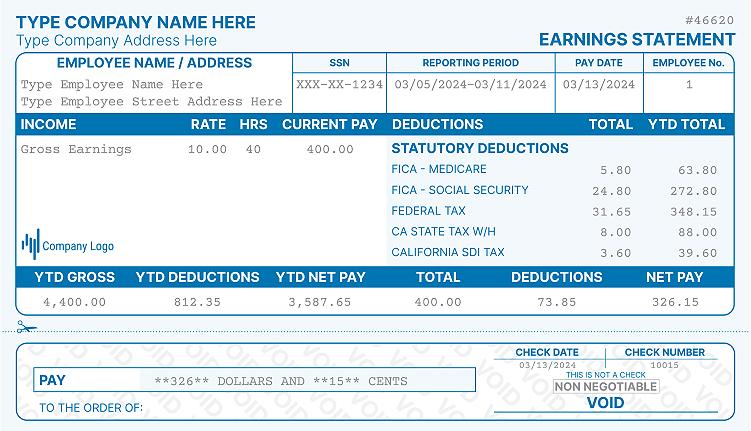What Is a Prorated Salary, When to Use It & Other Questions Answered
In an ideal scenario, you’re dealing with salaried employees who always work full-time. You know exactly how much you have to pay them over a certain period and what amount to reflect in the paystub.
Sometimes, however, salaried employees don’t work their full hours. In such instances, a prorated salary has to be calculated.
Understanding what a prorated salary is and how it differs from a full wage will help you make adequate calculations that are properly reflected in payroll and financial documents. The following guide will provide four simple steps, as well as a detailed overview of prorated salary scenarios that employers may have to face sooner or later.
Table of Contents:
What Is a Prorated Salary and How It Works
Simple Tips on How to Prorate Salary
Determine if the Current Situation Is One Under Which Prorated Salary Calculations Apply
Prorated Salary and Part-Time Employment Aren’t the Same
How to Calculate Prorated Salary - Example
You’ve Calculated the Prorated Salary – What’s Next?
A Prorated Salary Calculator – How Reliable Is It?
How to Calculate a Prorated Salary in Four Easy Steps
Use Hourly Rate to Determine Fixed Salary Deduction
What Does Prorated Salary Mean and How Does It Impact Your Payroll: Final Verdict
What Is a Prorated Salary and How It Works
Put in simple terms, prorated salary is a part of the salary that’s proportionate to the amount of time that the respective employee has worked. There are various scenarios in which a prorated salary applies and will need to be calculated:
-
Whenever a new employee is hired after the beginning of a pay period
-
In case an employee is terminated after the beginning of a pay period
-
Whenever an employee takes time off for reasons like participating in jury duty or due to a military leave
-
In instances when employees get promoted after the beginning of a pay period
-
Whenever an employee receives unpaid leave under the Family and Medical Leave Act (FMLA)
Essentially, the amount that an employee will get paid is going to be adjusted for a time period. A very simple example is this: in the case of the annual salary of 100,000 dollars and a person getting hired on July 1, that employee will receive a prorated salary of 50,000 dollars for that year.
Simple Tips on How to Prorate Salary
Let’s focus on another important inquiry – how to prorate a salary.
A four-step guide will be featured in one of the coming sections but we need to take a look at a few simple tips first.
1. Always Check Contract Terms
The contract under which an employee is hired should feature some information on prorating specifics.
For example, it’s a general provision for employees that are hired in the middle of a pay period (let’s say a month) to receive a prorated salary that’s rounded up to the nearest full month. Such stipulations can give you a formula to simplify calculations.
2. Determine if the Current Situation Is One Under Which Prorated Salary Calculations Apply
Prorated salaries don’t apply to all instances in which a worker has failed to perform throughout the entire pay period.
According to the US Department of Labor, you can’t reduce the salary for a pay period if an employee has underperformed or failed to meet a certain quota, for example. Thus, variations in work quality are not a valid reason for the initiation of prorated salary calculations.
Prorated salaries are also inapplicable in instances when employees are habitually late or when they have to leave work for a medical appointment or a family emergency. The situations in which a prorated salary is legal to apply have been outlined above.
3. Prorated Salary and Part-Time Employment Aren’t the Same
Here’s another important distinction to make – prorated salaries and part-time payments can’t be used interchangeably.
A part-time payment is agreed upon for a certain number of work hours that don’t amount to full-time employment. Prorated salaries apply to salaried employees who have worked a reduced number of hours during a pay period because of a valid reason.
4. How to Calculate Prorated Salary - Example
Let’s go with an hourly rate example to give you a better idea of how the math works here.
Imagine the following scenario – Michael is supposed to work one hour during a particular day but he only works 45 minutes. For a full hour of work, Michael gets paid 30 dollars. So, what would his prorated salary for that period be?
For a minute of work, Michael gets paid 0.5 dollars. That means that for 45 minutes of work, he’s going to receive 22.5 dollars:
-
Payment per minute: 30:60 = 0.5
-
Payment per 45 minutes: 45x0.5 = 22.5
You’ve Calculated the Prorated Salary – What’s Next?
After making the calculation and double-checking the figures, you’ll need to do a few additional things to complete payroll for that period.
You will need to generate a paystub that is reflective of the pro rata calculation rather than the full amount for that period.
Following the salary adjustment, you’ll also need to adjust tax deductions. The amount to withhold in Social Security and Medicare (FICA) taxes is reduced whenever a prorated salary applies. Federal income tax withholdings may also have to be adjusted.
Some kinds of paystub generators can automatically adjust tax calculations on the basis of the prorated salary. Make sure that the software you’re using has such capabilities. If that’s the case, you’ll simply need to enter the prorated salary and the deductions will appear automatically on the document.
A Prorated Salary Calculator – How Reliable Is It?
If you do some online research, you’ll come across at least a few prorated salary calculators.
Learning a bit more about the algorithm they employ and the calculations that result from this formula is very important.
The first step before choosing such a calculator would be to make sure it applies to US employees. Pro rata payments are made in many parts of the world. Some calculators use legal and taxation frameworks from the UK or Australia, for example. Using such an online tool can result in some serious mistakes and penalties down the line.
Also, find out what pay periods such a calculator can be used for. Most often, these tools make pro rata adjustments for monthly pay. If your pay period is different, an online calculator may not be the best option.
Once again, a paystub generator (especially when used in combination with reliable payroll software) should automate prorated salary calculations, as well as determining taxes and other kinds of deductions. In case your platform is missing such capabilities, the time may be right to look for an alternative product. The good news is that many options are readily available.
How to Calculate a Prorated Salary in Four Easy Steps
Finally, let’s check out a simple strategy for the calculation of a prorated salary that’s going to work in most scenarios.
1. Calculate the Weekly Salary
As a general rule of thumb, start by trying to calculate a fixed sum for a given unit of time. The unit you choose will depend on the length of the pay period.
In most instances, a pay period is a month. To calculate the prorated salary, start by trying to calculate a weekly wage. For annual income, divide the full-time annual salary by 52 – the number of weeks in one year. That is the unit you’re starting with and depending on the specifics of the situation, you can go on to calculate fixed pay for an even smaller unit of time.
2. Find the Daily or Hourly Wage
Once you have the weekly amount, you can determine a fixed payment for a single day of work or for a single hour. Choosing one or the other depends on how your workers are getting paid and what the scope of the pay period is.
To calculate the hourly wage, divide the weekly salary by 40 – the standard number of work hours in a single week.
So, if the weekly salary is $1,200, the hourly pay your employee should be receiving is calculated using the following formula:
1,200 : 40 = 30
To determine the daily wage, divide the amount by five – the typical number of work days in a single week. Using the example above, the daily pay is going to be 1,200:7 = 171.43 dollars per day.
3. Use Hourly/Daily Rate to Determine Fixed Salary Deduction
Your hourly rate is 30 dollars. Now’s the time to calculate the amount that a fixed salary should be reduced by, depending on the amount of time that a person has been away from work.
Let’s say that an employee missed five days from the pay period because they were hired late. The deduction, in that case, is going to be 5x171.43 = 857.14 dollars.
4. Calculate the Prorated Salary
The final step is the simplest one. You have your fixed salary for the pay period and you have the deduction that resulted from missed hours of work. To calculate the prorated salary, you’ll simply need to use the following formula:
Prorated salary = Salary for pay period - deduction
If you have an employee who earns 4,800 dollars per month, the prorated salary that will result from the example we’ve been discussing in the previous sections is:
4,800 – 857.14 = 3,942.86 dollars
What Does Prorated Salary Mean and How Does It Impact Your Payroll: Final Verdict
Prorated salary calculations aren’t all that common but even if you have to make such adjustments to fixed wages, they aren’t that complex.
Initially, you may feel threatened by pro rata calculations and the subsequent reductions in tax deductions. Eventually, however, you’ll find out that the formula is simple and logical, no matter what the specifics of your pay periods are.
The one final thing we want to insist on again is the importance of using the right kind of software to generate payroll documents.
A good paystub generator will handle many calculations on your behalf, once you have the prorated salary figured out. So, don’t hesitate to look for such a software product. Not only will it speed up paystub generation, but it can also reduce the risk of serious mistakes that can wreak havoc on your company’s financials.
Kristen Larson is a payroll specialist with over 10 years of experience in the field. She received her Bachelor's degree in Business Administration from the University of Minnesota. Kristen has dedicated her career to helping organizations effectively manage their payroll processes with Real Check Stubs.

